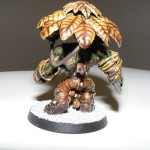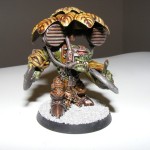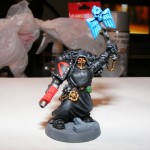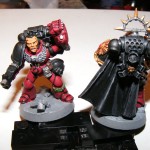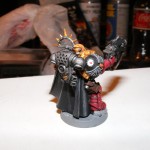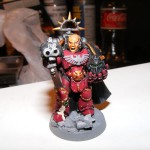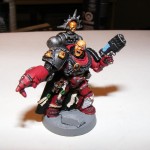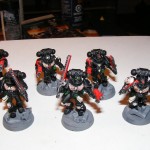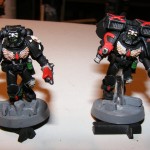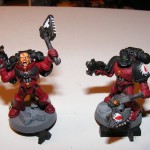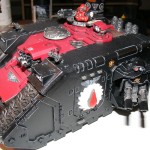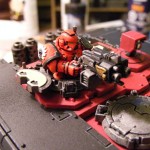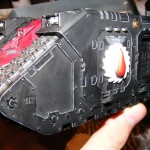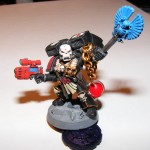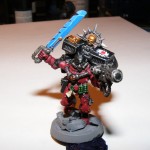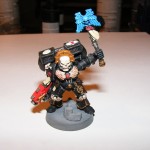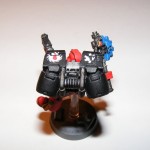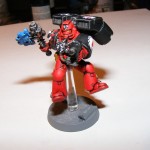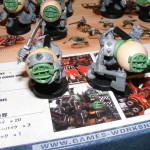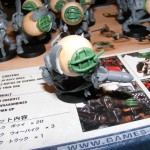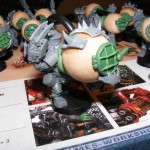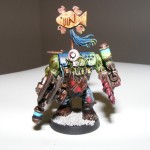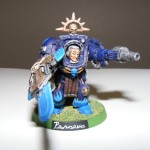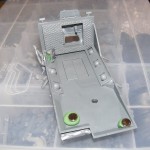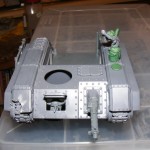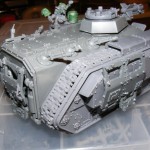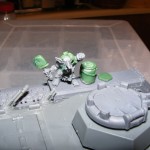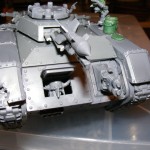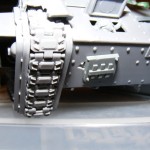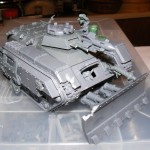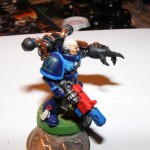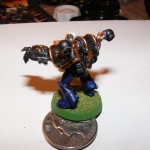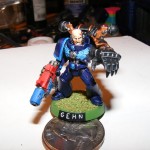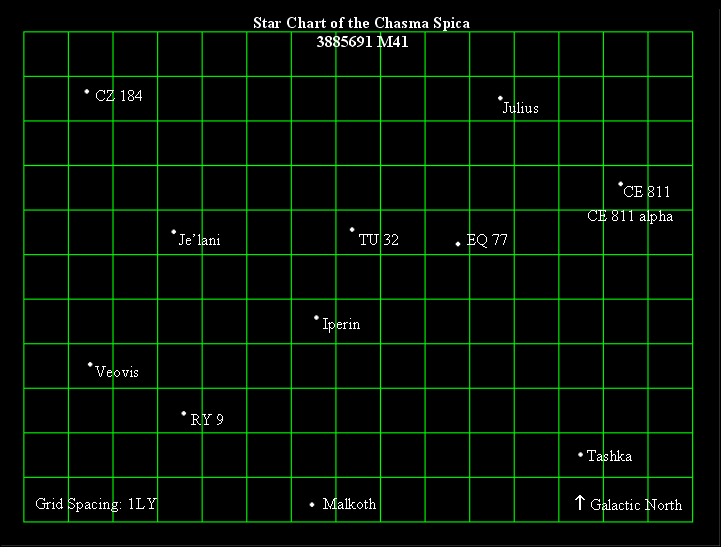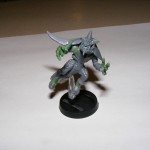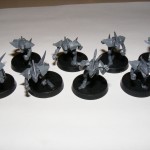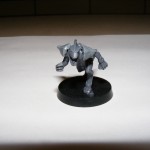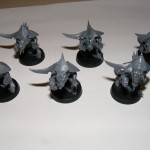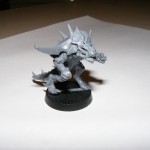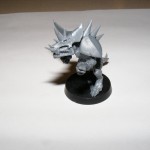Loudmouf Sneakilla
Loudmouf Sneakilla
Modeling
Loudmouf uses Snuikrot’s body. I used the head from the plastic Nob box that has Cylon eyes, and connected it with putty to fill out the neck. Into the neck and mouth-tube I inserted Guitar Wire that runs up to the speakers, which come from the Sisters of Battle tank sprue. The frame on his back is a sprue. The canopy is from the old plastic tree terrain sprue. Loudmouf’s custom Cesti (plural of Cestus) are sharpened pieces of sprue held on with custom sculpted putty vines to hide Snikrot’s dog tags. The switch on the back is putty and paper clip.
Backstory
The last words Loudmouf uttered with his own vocal chords were: “Oi! I just ‘membered dat I left me favrit squig at ‘ome!”
This was as his Kommando squad was about to infiltrate an Imperial Guard base and bring down the defenses so that Smartyskull could raid it. His Nob was less than thrilled when two thirds of the squad was obliterated by heavy bolter fire. Dragging Loudmouf by his neck all the way back to camp, the Nob deposited him before Smartyskull and asked for a judgment, as Da Boss always found funny ways to punish the stupid or careless. Smartyskull’s verdict was that because Loudmouf’s neck was so badly injured, that he should go see Dok Gilgivva, hur hur hur.
Loudmouf’s Nob didn’t like this verdict much; so on the way he took a large chunk of Loudmouf’s neck with him. This was the luckiest thing that could have happened to Loudmouf, as you can’t install gills into a ruined neck. With the help of Manik Upzindownz, the Dok installed another invention he had been working on, his patented loudener.
Once finished, Loudmouf was unable to utter any syllables below 130 decibels. The Dok’s new loudener also came with a very important feature: a mute switch. Though it tends to get caught on things, Loudmouf became adept at moving so that he doesn’t accidentally turn it on. This has made him the new paragon of Ork stealth. (So stealthy in fact that his Nob didn’t hear Loudmouf sneaking up on him.)
His signature weapons (custom made at great expense) are cesti (horseshoe shaped bars, sharpened along their outer edge), strapped to his forearms. This allows him to slash up Humies in combat while keeping his hands free to move underbrush, open doors, or muffle a sentry before he can shout. Loudmouf enjoys creeping up on an enemy, then turning on his loudener and shouting “WAAAAAAAAAAAGH!” in a blast that leaves the enemy temporarily deafened, and unable to hear orders. Then, he shuts off the loudener and melts back into the background, ready to pop out and kill again.
In remembrance of loves lost: my Flesh Tearers army
Once you’ve been gaming long enough, been desperate for cash enough, or simply let that fire go out for one particular army, you’ve sold off an entire force. Sometimes you put a lot of effort into a force of models, only to let those minis go for some cash you could have gotten by taking some overtime or selling blood. To every thing, turn turn turn.
I have only sold one army: my Flesh Tearers Space Marines. You may recall from previous entries that I won the initial seed of this army in the very last auction held at the Games Workshop in Novi, Michigan (now out of business). That was a huge emotional high. After years of seeing Joe’s Angels Sacrosanct take on all comers, I wanted to start some Blood Angels. It was originally my idea to have a Space Marine army for each primarch. Blood Angels seemed like the next logical step as a second army.
First I had to figure out WHAT Blood Angels to play. Joe’s army was a “normal” Blood Angel army, and so I wanted something a bit different. I remembered the Flesh Tearer list from the Index Astartes article and thought that would be perfect. Lots of great conversion opportunities, neat color scheme, and a doomed, heroic background. Plus, the extra chance of Death Company made it so I wouldn’t need a lot of Elite troops, as they were less worth it to take because they would be Death Company more often. It would keep the Tearers from getting out of control like the Azure Flames, who are barely contained in their new case.
The Index Astartes article had an “Imperial Chain Axe” and so I thought that would be my signature. I begged, borrowed, and bartered for Khorne Berzerker chain axes and used my trusty multi-tool file to file the chaos-y details off. I then custom sculpted double-eagles or Flesh Tearer logos on each axe. These details were 1/8″ wide and looked fantastic. These Axes would go on every sergeant, as by the rules the sergeant was the FIRST chosen for the Death Company, and I didn’t want to pay for power weapons. When these rules changed, I simply painted the teeth of the chain axes bone and said they were the teeth of the Dinosaurs of Cretacia, the Tearer’s homeworld, and they counted as power weapons.
At the time, Chapter Master Seth had no special rules of his own. (he now has some and a bitchin’ ass model too!) So I used the Salamanders Chaplain Xavier model, Dante’s Melta Pistol, and a wicked looking jagged sword. Seth was my stand-in for Dante, just as my modified Tigirius (the OLD Tigirius as the new one has a stupid face) was my Mephiston.
I also had (not pictured below) four Rhinos with the Razorback hatch. When I wanted a Razorback I popped in a gun. When I wanted a Rhino, I popped in a custom hatch with a berserk Flesh Tearer popping out, or a hunter-killer missile! These Rhinos had custom rear doors and openable side doors!
All of my Death Company were modded onto flying stands so that they flew. My greatest triumph (sadly not pictured) were my Veteran Assault Marines. These were all RIDICULOUS conversions. Almost all of them had Woo-style pistols. One was modeled after the art of an assault marine kicking two orks in the face while shooting two pistols. Another was actually shooting a pistol BEHIND HIS BACK. One was diving to the side, another had two plasma pistols firing two directions. One had a flamer, holstered to the side, while he was wielding a chainsword as tall as he was! One had a Dante melta pistol and a melta gun! I modded all of these during the power outage of 2003 to keep from killing myself from boredom.
Sadly, I lost interest in the Tearers as the White Dwarf list came out and made them a little boring. Yes, the list was more balanced and fair, but it also took some of the randomness out of the army and therefore some of the fun. I took them to Adepticon 2009 and sold them piecemeal. One guy bought the Rhinos, saying he was going to strip them. They had fully detailed and painted interiors. *sniff* My painted characters and Death Company went like hotcakes. The converted Assault Marines went almost immediately. Finally, the remaining Tactical Squads, loose minis, and the custom made case was sold to a kid who was buying his FIRST ARMY. I felt a lot better about selling them at that point. I made a kid really happy and and made a bunch of money.
The bottom line is that I sold the Flesh Tearers because even though I owned them, they weren’t MINE. The Azure Flames were MINE. I made their stories. I rose and fell with them. I felt the pain of their losses and the joy of their victories. Some other dude created the Flesh Tearers and it was fun to play them. But I realize that it’s hard fo rme to want to build, paint, or play with an army that wasn’t my own creation. So I abandoned my dream of owning a Space Marine army for each Primarch and instead found armies that I could create. This led to Poindexta Smartyskull’s warband and the Saratogan 58th.
Sometimes I miss the Flesh Tearers. I did some INCREDIBLE paint jobs and conversions. But I don’t regret selling them, no matter HOW overpowered the Blood Angels are now. For your viewing pleasure, here is an image dump of all the pics I took of the Tearers.
Ol’ Dok Gillgivva
Modeling
Dok Gillgivva was made mostly from an Assault on Black Reach Nob. The Klaw and Bionik arm are from the plastic Nob box. I carved down a Slugga for the left bionik arm. To both arms I added syringes made from thick plasticard rods, paperclips, and Space Marine Meltabombs with the middle square bits carved out. The Head light was custom sculpted. I cut the goldfish out of plasticard, and added plasticard gills and used a pin vise for the eye.
Gillgivva was painted like my other orks, with dipping. I then added some dynamic lighting effeccts from the green liquid on his left arm to make it look like it was glowing.
For the ‘Ard Boyz, I used wooden spheres for the heads and custom sculpted the victorian grilles. The tubing is Lego Pneumatic tubing, and the air tanks are Imperial Guard Flamer tanks.
Backstory
Ol’ Dok Gillgivva earned his name when he realized that the skin of a slime squig, carefully applied to an incision on a Boy’s neck, could filter “da good stuff” out of water, essentially giving an Ork gills, allowing him to breathe underwater.
His first experiments did not breathe water well, so to compensate, he used multiple slits, all around the neck. This improved water breathing efficiency, but made the Ork unable to breathe regular air. To compensate for this, he sends them to Manik Upzindownz, the Mad Mek, who sells them an expensive apparatus designed to let them carry around a water supply. Designed by Gillgivva himself, this system incorporates water containers coated with that same slime squig skin, allowing the water to be re-oxygenated and sent to a helmet where the Ork can breathe it in.
To protect their new weakness, most of Gillgivva’s “patients” become Ard Boyz, armoring themselves and their water supplies. Though they can breathe underwater, this prevents them from being amphibious as the armored packs are heavy, and without them they could not leave the water. These Ard Boyz tend to hang around Gillgivva, because after all, gills need maintenance and he has not found a way to give you gills twice.
Gillgivva was the Dok who put Poindexta Smartyskull’s brain(s) in, and Smartyskull keeps him around, protecting him from his victims in exchange for a promise never to give Smartyskull gills.
Liam Perseus, Chapter Master of the Azure Flames
Modeling
I made an old model of Perseus with the Terminator Captain with Storm Bolter model years ago, but he wasn’t that great. The cabling looked bad and his storm shield was tiny. My original idea was that it be a shield that incorporates weaponry, so that a successful block can be a slice as well. The original model did not do it justice.
For the new model, I used Marneus Calgar’s upper torso, modified to get rid of the stupid eagles. I used the Devastator Sergeant head, with an elongated nose. I added a third and fourth service stud, as Perseus is about 400 years old. The legs are the plastic legs from an Assault on Black Reach Terminator sergeant, with the flame added to the right knee pad. On his back to cover up Marneus’ Bolter ammo feeds, I added some purity seals and scrolls. I also added an Iron Halo on top.
For the arms, they are double dry-pinned with a magnet holding them on. the pins come out of the torso, and the pin holes in the arms are deep, but are wide at the top so the pins slide right in. You can pick up Perseus by any of his arms and he won’t fall apart, or change his pose.
Perseus’ Storm Shield was made from the Masters of the Chapter Storm Shield, and two plastic power axes and two pewter Bike sergeant power swords. The Grenade arm is a standard Storm Bolter arm, with an Imperial Guard grenade launcher.
The Thunder Hammer/Storm Shield combo is the normal plastic one from the Termintator kit, with the Hammer modified with putty.
Paint used the standard Azure Flames color scheme, with a few embellishments on the feet and cape.
Backstory
Liam Perseus is a Terran. His parents were pilgrims, and ended up serving the Ecclisiarchy on Terra itself. He was born into servitude on Terra, and luckily for him, was a young teenager when the Tech Priests of Mars, at the behest of Inquisitor Eric Boucher, decided to make a Salamanders successor chapter. Liam was simply scooped up by a Tech Priest, as his parents told him that he was destined for greater things.
Liam was one of the thousand Space Marines delivered to Nocturne as the Sons of the Salamander. No Son had rank yet. Being trained in the arts of war by their parent chapter caused Perseus to stand out. His natural leadership qualities and powerful personality made him one of the first Sons of the Salamander to be promoted to Sergeant.
As the chapter structure took hold, Salamander Apothecaries noticed something strange. The Sons were not affected by the radiation on Nocturne. Perseus and his chapter brothers’ skin was not turning black, nor their eyes red. One battle brother died in training, and the Apothecaries examined his gene seeds. From that point on all Salamander and Sons of the Salamander Apothecaries were forbidden to speak of the possible genetic variance. The official word was that they are a Vulkan chapter and the matter was closed. Rumor persists to this day.
Perseus, being trained by ecclisiarchs as a child, found the Promethean Cult a bit dubious until he found the joy of making weapons. He hand-crafted his first sword. He insisted on using it to join in the yearly Salamander hunts on Nocturne. Sadly, this sword was destroyed in the hunt when Perseus used it to prevent himself from falling into a volcano. Perseus did bring home a Salamander pelt, but not the biggest. Undeterred, Perseus used the pelt to make a shield.
Forty seven years of distinguished service as a sergeant followed. Perseus fought traitors and aliens with equal fervor. He was among the first to re-paint his armor when the Sons of the Salamander became the Azure Flames. He fervently believed in Atrus’ vision.
His shield was severely damaged in a fight with the Iron Warriors. He used it to block the attack of the traitor’s Power Fist. The shield shattered like glass, and so did the bones in Perseus’ arm. Perseus used the shattered remnant strapped to his arm as a weapon, jamming it into the traitor’s neck.
Perseus was soon promoted to the First Company, and chose the wargear of the Thunder Hammer and Storm Shield. He was a part of the third Terminator squad during the invasion of Hive Fleet 2501 in the battle for the North Complex on Landon. Atrus personally accompanied his squad, and Perseus watched as a Hive Tyrant cut him down. Perseus smashed the Tyrant’s head with his Thunder Hammer, but Atrus was too far gone to save. Perseus heard Atrus’ voice begging to be interred in a Sarcophagus. He demanded that it be done. It was. Perseus became Captain of the First Company thereafter, and took on the duties of Chapter Master when appropriate. Atrus was still the de facto Chapter Master.
Perseus took up a new project. He remade his Storm Shield into a weapon, and trained with it to develop a new fighting style. He became known as an invincible relentless combatant, able to turn the tide against the most skilled opponent.
When Atrus died in the Chasma Spica conflict, Perseus took his rightful place as the Chapter Master. He decreed that Iperin, the planet on which Atrus died, was to be the new homeworld for the Azure Flames. Every Space Marine chapter in the Chasma Spica conflict backed up his claim.
Perseus has overseen the Chapter’s combat service. He directs them to war torn zones where the Azure Flames go out of their way to protect refugees. Under this policy, refugees are relocated to Iperin, where they are given a new home in the rebuilt capital of Releeshan. Perseus’ kind but stern leadership style and aged appearance has earned him the nickname “The Old Man.” He struggles with the authority left by Atrus’ death, and works hard to groom Atrus’ gene-son Antonius for the day Perseus falls in battle.
Rules
When Perseus has a Thunder Hammer and Storm Shield, he is the Captain of the First Company and stands in for Darnath Lysander. With his shield and grenade launcher, he has the following profile.
HQ – Chapter Master Liam Perseus: 260 Points
WS: 6
BS: 5
S: 4
T: 4
W: 4
I: 5
A: 4
Ld: 10
Equipment: Terminator Armour, Perseus’ Storm Shield, Auxilliary Grenade Launcher, Teleport Homer.
Special Rules
Eternal Warrior
Perseus’ Storm Shield: Perseus customized this tower sized Storm Shield by adding power weapons all along the perimeter. This makes the shield into a targe, used for both offense and defense. Perseus’ Storm Shield counts as both a Storm Shield and a Relic Blade. In addition, Perseus’ unique skills combined with the dangerous proposition of attacking an object covered with power weapons allows Perseus to re-roll all rolls in close combat to hit and to wound.
Riposte!: Perseus is a master of allowing an enemy to overextend themselves, and taking advantage of even the tiniest opening. In close combat, any successfully made armour or invulnerable save grants Perseus an extra attack at initiative 1. If Perseus is killed before initiative 1, the attacks are lost.
Orbital Bombardment: Perseus can call down an Orbital Bombardment, as detailed in the Chapter Master entry in the Space Marine Codex.
Telling a story with your model.
You can use modeling to tell a story without saying a word. I made a looted Ork vehicle. Look at all the pictures, try to see what the story behind the vehicle is, and then scroll down past the white space.
.
.
.
.
.
.
.
.
.
.
.
.
.
.
.
.
The Story
As you can see, there is damage to the front track guard and right side front hull. The Chimera was hit by severe antitank fire, coming from its right side. This immobilized it and allowed the Orks to capture and loot it. The rear door was ripped off and replaced. The damaged laser turret was upgraded to a Rokkit Launcha. That’s how this vehicle joined Poindexta Smartyskull’s warband. I tried to explain this with the way I built it. Some people loot Ork vehicles by just slapping gubbins on wherever. That’s fine, but I like my idea better.
Finally, as an extra modelling goody, I modeled Red Paint Job as something other than a red paint job. Of course there will be some red at the end, but it will get there because of Vincent Van Grot, on the top left side. He even has a bandage on his ear!
Gehn the Traitor, disciple of Matthius.
Modeling and Painting
Before Big Game 5, Matt Turner came down to help us build terrain. While he was there, we discussed his Chaos Lord, Matthius, Prophet of the Four. Matt said that he wanted Matthius to have a bodyguard of traitors from various armies. I wasn’t sure about other people’s armies, but I instantly came up with an addendum to the main fluff story that involved this man:
I used the new Devastator Sergeant head, with the flat top filed away. I used the Mark 9 sergeant armor torso, the old pewter bolter-melta, and a Chaos power fist, shoulder pad, and backpack. The body was damaged as if it had suffered an explosion on Gehn’s left side, which is the arm that was replaced. He was painted with the Azure Flames scheme, with a scheme similar to some of Matt’s chaos squads on the replaced arm. Gehn was given as a gift to Matt before Big Game 5.
Background
The name of Gehn is cursed by the Azure Flames more than any other. While the twists of Chaos have poisoned, mutated, or brainwashed battle brothers before, these individuals were exterminated. Unlike others, Gehn chose to betray the Chapter. The path between his recruitment and that fateful choice is twisted and convoluted. This account merely scratches the surface of the events that led Gehn to choose madness over loyalty.
Gehn’s recruitment into the Chapter, like most battle brothers, came when his world was in need. Riven was raided by Dark Eldar pirates for slaves year after year. Losses were deemed minimal by Imperial tacticians, due to the fact that Riven had always made its imperial tithe. Calls for aid went unanswered or were spectacularly late. In c783m41, the Dark Eldar met their match. The Battle Barge His Anvil leading approximately half the Azure Flames fleet met these raiders head on. In a pincer action, the Dark Eldar ships were corralled by escorts as capital ships closed in. Sadly, the captives aboard the ships perished in the attack, but the Dark Eldar raiding force was dealt a severe blow. As is customary, the Azure Flames requested that all boys of age be allowed to prove themselves worthy of joining the Chapter. Gehn was tested and proven well above his peers in the rigorous mental and physical challenges that all aspirants to the Azure Flames are put through, and the promising youth was quickly inducted into the Chapter.
Gehn’s career as a scout was not without glory, but was lackluster compared to some of his contemporaries. He was eventually chosen and passed the final trial to become a Space Marine, and served in the reserves for 60 years before joining the 4th Company. It is at this point that Gehn’s career became more illustrious. He participated in the raid on Arkh, and played a vital role in capturing the hidden ruling council. After several decades of service, he was eventually promoted to sergeant. During his tenure he killed a Carnifex in close combat and was at the forefront of the push to take the Traitor’s Gate on Yttran. Gehn’s ambition made him to continue to strive to become a captain, but though his service was admirable, no position of Captain was ever available.
Then Antonius was recruited into the Scouts. Gehn took notice when Antonius was advanced to Space Marine faster than any other Scout on record. He then became enraged when the youth was promoted to Sergeant of the 5th Squad, 4th Company after the infiltration action on Iperin during the Chasma Spica conflict. During Antonius’ induction ritual, Gehn refrained from joining in the toast. Antonius thought nothing of it, but Captain Ganendra did. He notified Atrus, and Atrus consulted his visions of the future. To his horror, the visions spoke that Gehn would betray the Chapter. Atrus sought to send the 4th Company into battle on Julius, and had Ganendra use the 6th squad as bait for the enemy. Gehn and his squad were hit by the blast of a battle cannon. Gehn was knocked unconscious and captured by Chaos forces led by Matthius, Prophet of the Four.
Gehn was interrogated and tortured by Matthius’ subordinates until Matthius himself gave a cryptic order to bring no more harm to the prisoner. Matthius personally interrogated Gehn for several days. Hints and whispers that only Matthius hear from the Gods of Chaos guided him. Then came the secret – Matthius learned that Antonius was the gene-son of Atrus. Matthius used this information to batter holes in Gehn’s tired, damaged faith. As Matthius slowly revealed the truth, Gehn’s hatred for Antonius eclipsed that which he felt for the Dark Gods and their minions. Here was a boy promoted through deliberate favoritism while Gehn was passed up time and time again. That was not just. Gehn wanted more, and Matthius promised it. Gehn fell to Chaos with one word: “Yes.”
Gehn’s knowledge of Azure Flames security protocol proved devastating. While his codes were invalidated, he knew how certain individuals would act. Matthius’ forces penned in the beleaguered 4th Company with the help of mentally-enslaved Orks. Gehn saw fit to taunt his former allies through transmissions while the forces of Chaos closed in around them. His name was spoken as a curse by the entire Chapter as his betrayal was revealed.
The victory of the imperial forces at Daskros changed little about Gehn’s ambitions. Though he fought for his life against the newly freed Orks, he escaped from the Chasma Spica alongside his new master Matthius. He now fights for power and glory, to exult the Gods who recognize his greatness. Above all, he waits for the chance to exact his revenge on the upstart boy that had everything handed to him. Thus through jealousy did Gehn fall.
Just as Tzeentch told Matthius he would.
Poindexta Smartyskull: The Ork with two Brains.
Conversion and Painting
A rather simple conversion, but a good one. I took Ghazgkull, sawed off the bottom of the cow-skull banner, and replaced the pole with a brass rod. I cut a brain shape and a lightbulb shaped skull out of plasticard. I then cut a smaller circle, to be the banner’s monocle.
For Smartyskull’s head, I had a square piece of plastic left over from a Trukk conversion. I coated this with putty, and put it on his left side of his head (seen on the right in the photo). I then filled out the other half of the head with a blob of putty that is much more rounded. I added some small sausages of putty to the front of the head, and flattened them slightly to make the veins.
The monocle is a simple Ork shoota crosshairs bit, with the insides and outsides smoothed. The chain is a thin strand of putty.
Smartyskull was painted using the same dipping technique seen in my dipping post.
Backstory
Dexa was just a regular boy until he unwittingly took a bolter round to the head for his Warboss. The Boss ordered the Dok and the Mek to rebuild Dexa’s head. Dok Gillgivva wanted to use a nice shiny Ork brain, put together piecemeal from those previous owners who hadn’t quite made it on the operatin’ table, and also to install some shiny new gills. Manik Upzindownz da Mad Mek wanted to try out a new cybork brain he had made from several good bitz, including the machine-spirit thingie from a Beekie Land Raider and his best pocketwatch. As Orks often do, they came to blows until the Boss broke them up and told them to work together or else he’d smash both of them good.
So they used both brains. They had to weld a lot of armour, and use a discarded skull here and there for spare bits of bone, but at the end, Dexa had a shiny new lightbulb shaped head. Dexa got a lot smarter after that, and intuitivley knew High Gothic, as well as gained an aptitude for strategy and logic. He was smarter than lots of sumboys!
After this the Nob of Dexa’s slugga boyz met with an “accident” when his power klaw “malfunctioned,” and Dexa took all of his stuff. Dexa grew in size, as Orks who challenge thier superiors do, until the boss noticed that Dexa was a threat to his power. Luckily for Dexa, he saw the boss sneaking up on him, sidestepped the Boss’ choppa, and shot the boss in the throat, then the head twice. The Boss’ most loyal Nob stepped up to give Dexa what for, and Dexa shot him point blank.
“Anybody else wanna ‘ave a go?” Dexa inquired. No one stepped forward. Dexa became the new boss and insisted on being called Poindexta. Due to his large cranium and his flair for strategy which led them to several successful raids, he earned the nickname Poindexta Smartyskull. He rules his tribe with a combination of low kunnin and head krumpin. He has most of the major tents or structures bugged, and bribes gretchin to be his (unreliable) eyes and ears. Lone dissenters are shot in the back or cut in half with a power klaw, and groups are incinerated by a loyal Burna boy. Poindexta Smartyskull leads his Blood Axe warband through the stars, trying to reconcile the conflict between the Ork part of his brain that loves a good fight, and the man-made computer that makes him insightful, witty, and urbane. He loves to take human prisoners because he needs someone to talk to, though his nobs often ruin the conversations by butting in.
The Star Systems of the Chasma Spica
The Star Systems of the Chasma Spica
An Astronomical and Geological Report by the Emperor’s Humble Servant: Magos Tukmehn Kelhar
Abstract
The Chasma Spica has long been closed to Imperial surveyors due to an ever-present Warp Storm. I had the fortune of being a guest aboard the Adeptus Mechanicus Explorator ship Menelaus during its discovery that the Warp Storm had dissipated. The Chasma Spica consists of a relatively dense region of space approximately 15 LY by 10 LY in the Segmentum Tempestus to the Galactic Southwest of Pavonis. It contains eleven previously recorded but unexplored Star systems. Surveys discovered that six of these systems have valuable planets. These six systems were renamed, to better identify them. Due to enemy presence, a full Geologic survey of each planet was impossible. However, with the assistance of the Azure Flames Adeptus Astartes chapter, data about each planet was gathered to the maximum degree possible.
Methods
Due to such a large number of star systems being explored in such a short period of time, the Azure Flames Adeptus Astartes Chapter assisted me by relaying their sensor data. They also launched several class theta probes to gain more information about each world. Long range sensors of the Menelaus were also used to gather information in several systems. Planetside surveys are impossible, due to unknown disposition of Chaos forces in the Chasma Spica. Several systems have very little data due to the interference of Enemy fleets.
Observations and Data
The Chasma Spica is a dense region of space. Systems are usually 2.4 to 3.8 LY from each other. The Warp storm encapsulated this entire region and an area 13 AU beyond it, denoted in previous star charts. Most of the systems are clustered around the Iperin system, with notable exceptions being the Tashka System and the CZ 184 system. Isotopic analysis of dust clouds in all eleven of these systems confirms that these nine clustered systems originated from the same parent nebula. Data collection was hampered significantly in the Je’lani and CZ 184 systems. Long range scans of these systems and brief sensor data are avaialble. Detailed observations will proceed from Galactic North to Galactic South.
CZ 184 is a Red Giant star class K. Observed surface temperature is 4,182 K. Luminosity is 2.43×10^28 Watts. No sattelites detected. Data are from long-range sensors only due to enemy interference.
Julius is a main sequence star class F. Observed surface temperature is 6,616 K. Luminosity is 4.47×10^27 Watts. Julius has three main satellites. Julius Alpha is .87 AU from Julius and has a radius of 5731 km. Due to the high temperature of Julius, and Julius Alpha’s proximity to it, and its small size, Julius Alpha has no detectable atmosphere. Tectonic forces are prevalent on Julius Alpha. Several volcanoes appear on its surface. Long-range laser seismographs aboard class theta probe indicate almost constant earthquakes. Julius Alpha is designated class delta, a dead world. Julius Beta is 1.61 AU from Julius and has a radius of 6,403 km. Julius Beta has a nitrogen-oxygen atmosphere consistent with alpha class agri-worlds. Julius Gamma is a Gas Giant 3.95 AU from Julius. Julius Gamma’s radius is 80,349 km. Julius Gamma has fourteen minor satellites. One of which, Julius Gamma Kappa, has a carbon dioxide atmosphere and frozen water. Currently classified delta tau, death world. The Julius system also has two Asteroid belts at 3.08 and 4.87 AU of light density. Most asteroids in the first belt are iron-chondrites. The second belt is composed of both iron-chondrites and ice.
CE 811 and CE 811 alpha are Binary stars orbiting each other. CE 811 is a main sequence class A with a surface temperature of 8231 K. Luminosity is 4.51×10^28 Watts. CE 811 alpha is a main sequence red dwarf class K with a surface temperature of 4090 K. Luminosity is 1.93×10^25 Watts. The CE 811 system is full of gas and dust clouds, possibly formed by extreme solar prominences during early collisions of the stars.
Je’lani is a main sequence class K with a surface temperature of 4432 K. Luminosity is 6.04×10^25 Watts. Je’lani has one satellite, Je’lani alpha, a Gas Giant at .74 AU. No further data due to destruction of probe by enemy incursion.
TU 32 is a White Dwarf class A with a surface temperature of 7743 K. Luminosity is 2.66×10^22 Watts. Large amounts of gas and dust clouds and asteroid fields indicate that TU 32 was much larger and went nova as it accreted a hypothetical gas satellite.
EQ 77 is a Red Dwarf main sequence class M with a surface temperature of 2973 K. Luminosity is 1.362×10^23 Watts. Asteroids and gas and dust clouds present in great amounts. EQ 77 was most likely a larger Red Giant that ran out of Helium and collapsed. It is currently fusing larger elements to stay lit. It does not have the mass required to collapse into a singularity. EQ 77 has one minor satellite, EQ 77 alpha, at 4.2 AU. It has an average radius of 1973 km. EQ 77 alpha is extremely irregular and completely uninhabitable.
Iperin is a main sequence star with a surface temperature of 5814 K. Luminosity is 1.034×10^26 Watts. The Iperin system has several satellites. Iperin Alpha is .709 AU out, and has a radius of 3107 km. Iperin Alpha has a thin CO2 atmosphere, similar to the proto-atmosphere of Mars. Infared readings and tectonic scans indicate no internal planetary energy; hence Iperin Alpha is classified as a class delta, dead world. Iperin Prime is 1.13 AU out and has a radius of 5,982 km. Despite the smaller radius, gravitometric scans indicate that surface G is approximately 1, which leads me to believe that the core of this world is slightly more enriched in Iron than Holy Terra. Magnetic readings unavailable. Atmosphere is a 65% N2, 18% O2, and 12% Argon, with variable other gases such as CO2 and water vapor. High-orbital photography indicates complex weather systems, two main continental masses, and a large planet-spanning ocean. Ice caps exist on both poles. The southern continent is also partially covered by ice. Tectonic scans indicate that this is a geologically active world. Iperin prime also has two moons, Iperin Prime Alpha and Beta, which orbit at distances of 10,342 km and 14,376 km respectively. Both moons are delta class dead worlds and have no atmospheres. Iperin Prime is designated alpha class. Iperin Gamma is 1.9 AU out and has a radius of 1,903 km. It has a thin atmosphere composed of CO2 and other trace gases, and is designated a class delta dead world. Iperin Delta is a gas giant 4.38 AU out, and has a radius of 80,311 km. Iperin Delta has an extensive system of rings, numbering approximately 483. Iperin Delta has several hundred moons, all of which are asteroids or delta class dead worlds with a radius of less than 1,500 km, except for one moon designated Iperin Delta Upsilon. This moon has a radius of 3142 km and has an atmosphere compsed of 32% water vapor, 54% CO2 and 10% O2 with other trace gases. Iperin Delta Upsilon has liquid oceans that undergo huge tidal action because of the moon’s proximity to Iperin Delta. This tidal action causes friction, which keeps the oceans liquid despite Iperin Delta Upsilon’s distance from its star. According to spectrographic scans, these oceans are rich with chloroplast bearing lifeforms which provide the oxygen component of the atmosphere. The carbon dioxide rich atmosphere means that human beings should wear CO2-scrubbing respirators while on Iperin Delta Upsilon. Several volcanic islands dot the moon’s surface, and tectonic sensors show incredible stress on the moon’s plates, probably due to the same gravitational shearing that cause it’s tidal action. Iperin Delta Upsilon is designated delta tau, death world, due to its treacherous shifting oceans, tectonic and volcanic action, and extreme temperatures. Iperin Epsilon is a gas giant 7.12 AU out, and has a radius of 58,984 km. It has a minor ring system numbering 13 rings, and has several moons, none of which are significant.
Veovis is a main sequence star with a surface temperature of 5,002 K. Luminosity is 7.9×10^25 Watts. The Veovis system has one primary satellite and several gas and dust clouds, and asteroid belts. Asteroid belts are located at 3.8, 4.7 and 8.2 AU out from Veovis. Veovis Alpha is a gas giant 1.83 AU out and has a radius of 97,313 km. Veovis Alpha has several moons, but only two moons of significance; Veovis Alpha Gamma and Veovis Alpha Zeta. Veovis Alpha Gamma is an iron-chondrite concretion approximately 847km in diameter. It has no atmosphere and is designated delta class, death world. Veovis Alpha Zeta is 1,382 km in diameter and has an atmosphere composed of 63% CO2, 23% water vapor, 12% H2SO4, and 8% complex hyrdocarbons. Seismic readings indicate minor tectonic activity. Long-range spectrographic scans identified several large bodies of liquid on the surface of Veovis Alpha Zeta consisting of various complex hydrocarbons. Veovis Alpha Zeta is classified delta tau, death world.
RY 9 is a white dwarf with a surface temperature of 9,382 K. Luminosity is 2.38×10^23 Watts. RY 9 has several gas and dust clouds, and scattered irregular asteroid fields.
Tashka is a giant with a surface temperature of 4,587 K. Luminosity is 1.87×10^28 Watts. The Tashka system has one major asteroid belt at 3.63 AU from the primary. Tashka has two primary satellites. Tashka Alpha is 2.65 AU out and has a radius of 2,982 km. Tashka Alpha has no atmosphere and is designated delta class, dead world. Tashka Beta is a gas giant 4.74 AU out and has a radius of 91,283 km. Tashka Beta has a ring system numbering 37 rings. Tashka Beta has five moons, the only significant moon of which is Tashka Prime. Tashka Prime has a radius of 4,782 km and has an atmosphere composed of 63% N2, 21% Argon, 12% O2, and other trace gases. The moon has several liquid oceans and consists of mostly volcanic archipelagoes with one major continent straddling the moon’s equator. Tashka Prime is classified lambda class, livable world.
Malkoth is a main sequence star with a surface temperature of 6,359 K. Luminosity is 1.6×10^26 Watts. Malkoth has asteroid belts at 4.3 and 11.6 AU. Malkoth also has extreme gas cloud distribution and random asteroid fields ranging from 6.9 to 7.3 AU out. Possibly remnants of two or more gas giants that collided or were torn apart somehow. Malkoth Alpha is 1.3 AU out and has a radius of 5,612 km. It has an atmosphere composed of 68% N2, 28% CO2, and other trace gases. Tectonic activity is minimal. Extensive life signs detected from orbit, type unknown.
Conclusions
The Chasma Spica has an incredible wealth of unexplored livable or exploitable worlds. Several of the dead worlds in a variety of systems would be perfect for class rho research stations. Julius Beta, Iperin Prime, Iperin Delta Upsilon, and Tashka Beta Delta are currently habitable by human beings. Julius Beta is the ideal candidate for an agri-world, but is too valuable for its cropland than for any other purpose. Iperin Delta Upsilon would be suitable as an agri-world if the local life proves nutritious, or if a suitable replacement can be introduced. Iperin Prime and Tashka Prime are the finds of a lifetime. Both are extremely earthlike and could be put to any number of purposes including Hive worlds. Malkoth Alpha could also become usable after terraforming processes alter the atmosphere. Veovis Alpha Zeta is a hazardous world, but the natural complex hydrocarbons in its atmosphere and oceans are ideal for refinement into promethium and other fuels. I recommend that Imperial forces seize control of the Chasma Spica at all costs.
Magos Tukmehn Kelhar
Magos Supremis Geologis
Getting the Band Back Together
So one day my friend Scott came up to me and said “We’re doing another Big Game a year from now.”
I don’t know how to describe what I felt next because it was a new feeling. But it was awesome.
Here’s some history. Our old gaming group, Studio 40K, used to play in Mary Mayo hall. Every once in a while, we’d put on Big Games. The first and second Big Games took place on the floor of a pole barn on my friend Jake’s parent’s christmas tree farm. It was huge, but painful as we knelt on concrete for twelve hours. The third was on the 4th floor of the MSU Union, and then the fourth was back in the pole barn (because it was free). Players were divided onto the “good” and “evil” sides.
I had mixed feelings about the earlier games. In the first I wasn’t able to do much besides make Andy’s Necrons phase out, and one of our players was kind of screwed over. His name was also Andy and he played Dark Angels. He was told to take a 100% deep striking force, but was forced to deep strike within 24″ of an objective, so his army was essentially deployed randomly, piecemeal, in a useless place. He lost two units to the Perils of the Warp. We never saw him again. There was no fluff for this game, people just played.
In the Second big game, I was face-to-face with an outnumbering force of Eldar, and I had a mounted force ready to assault. Sadly, I was not allowed to move on turn 1, essentially turning my vehicles to tombs. The scenario also favored the “evil” side, as we had a Titan that was supposed to “march” to a city to liberate it. Unfortunately you can’t march if there’s an enemy within 48″ and the Evil side had John, a Tyranid player. His Lictors kept the titan from marching. This game had a backstory by Joe, that an evil artifact allowed Chaos to control other evil armies.
The third was essentially twelve small games going on at once. I faced John’s Tyranids across a “cornfield.” These were essentially forests that you could see 12″ into instead of 6″ like normal. However, John’s Tyranids could assault MORE than 12″. Half of my force retreated to help another board, but we had a lot of bad matchups. Guard vs. Necrons in the city could not pop Monoliths because they were hull down, and the Monolith blasted everything. Dan’s Tau marched (stupidly) right up Andy’s Necrons’ throat. Dave (former 21C manager) ran across a death field at an artillery heavy Iron Warriors army. Comedically there was ONE mismatch the other way. Brian’s Orks were trapped on the other side of a huge trench and were pounded by Damon’s Guard. Sadly the good guys had one guard plauyer whose name escapes me, and he was a huge cock the whole time. In this story, the evil sword from the first story continued to control the bad guys. It was now wielded by an Ork Warboss!
In the fourth, the game was much more balanced. In the end, Brian’s Ork bikers turned a Good Victory into a tie. I remember my knees being sore, and Scott almost died. The good guys really did not deserve to win, as we made several mistakes like deploying our Thunderhawk in the middle of the goddamn board. The evil sword was now in the hands of the nefarious Victor Kalan. His brother, Inquisitor Angmar Kalan, led the forces against him. To break the tie, Victor and Angmar fought close combat. They killed each other! A true tie!
So that’s where I thought it would have ended. Then Scott said that wonderful sentence. It led me to a year of some of the most intense creativity I have ever experienced. It also encouraged me to finish every little thing for the Azure Flames, including a bevy of named Captains.
Details on Big Game 5 to follow in a later post.
Blood Bowl: The Konquata Monitors
Recently I got into Blood Bowl. I haven’t played a game (due to a traffic jam DAMMIT) but I have a serviceable team raring to go. We are the Konquata Monitors, a Lizardmen team. Here is an image dump:
As you can see, I have six Saurus Warriors, eight Skinks, and two Saurus Star players. The Saurus were made from Temple Guard with Saurus Warrior left arms and Tyranid Carnifex armor plates. The Skinks have Genestealer armor plates cut in half. Each half makes one shoulder pad.
For the star players, there were no open hands available in the Lizardmen line. So, I used a piece of putty, coated it with oil, and wrapped it around the fist. Then, I CAREFLLY removed the mould and flattened it out. This gave me straight fingers. I then moulded the fingers over and over until I got enough to do each hand. Each finger was cut out, trimmed, and putty was added to fill out the finger. Putty was also added to make new nails. The one on the flying base represents the Star Player Lottabottol, who has diving catch. The other is Sillibilli who has block.
In the Warhammer Fantasy world, the Lizardmen have recently conquered the island of Albion, which they call Konquata. Lord Kroak personally formed the Konquata Monitors out of Saurus and Skinks from the First Spawning from the newly made spawning pools on Albion. Their mandate is to dominate the sport of Blood Bowl to advertise that Albion will belong to the Lizardmen for all time.
Next up: more Skinks including Star Player Hemlock, and a Kroxigor modded with Trygon bits!
